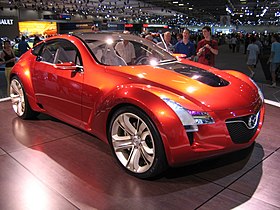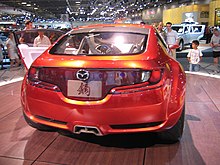
The Mazda MX-5 is a lightweight two-person sports car manufactured and marketed by Mazda with a front mid-engine, rear-wheel-drive layout. The convertible is marketed as the Mazda Roadster or Eunos Roadster in Japan, and as the Mazda Miata in the United States, and formerly in Canada, where it is now marketed as the MX-5 but is still commonly referred to as Miata.

A coupe or coupé is a passenger car with a sloping or truncated rear roofline and typically with two doors.

The Mazda RX-7 is a front-engine, rear-wheel-drive, rotary engine-powered sports car that was manufactured and marketed by Mazda from 1978 until 2002 across three generations, all of which made use of a compact, lightweight Wankel rotary engine.

The Mazda RX-8 is a sports car manufactured by Japanese automobile manufacturer Mazda between 2003 and 2012. It was first shown in 2001 at the North American International Auto Show. It is the direct successor to the RX-7. Like its predecessors in the RX range, it is powered by a rotary Wankel engine. The RX-8 was available for the 2003 model year in most parts of the world.

The Ford Probe is a liftback coupé produced by Ford, introduced in 1988 and produced until 1997. The Probe was the result of Ford's collaboration with its longtime Japanese partner Mazda, and both generations of Probe were derived from the front-wheel drive Mazda G platform that underpinned the Mazda Capella.

The Oldsmobile Alero is a compact car that was produced by General Motors for its Oldsmobile division. Introduced in 1998 as a 1999 model, the Alero was the replacement for both the Achieva and Cutlass. The Alero was Oldsmobile's last new model nameplate, and — on April 29, 2004 — was also the last Oldsmobile manufactured.

The Mazda MPV is a minivan manufactured by Mazda. Introduced in 1988 as a rear-wheel-drive model with optional selectable four-wheel drive, this was replaced in 1999 with a front-wheel-drive version with optional all-wheel-drive in some markets. Over one million MPV models have been produced since its introduction.
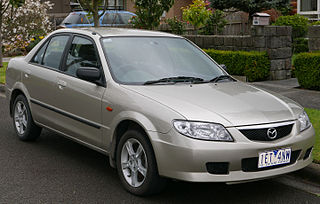
The Mazda Familia, also marketed prominently as the Mazda 323, Mazda Protegé and Mazda Allegro, is a small family car that was manufactured by Mazda between 1963 and 2003. The Familia line was replaced by the Mazda3/Axela for 2004.

A sunroof is a movable panel that opens to uncover a window in an automobile roof, allowing light and fresh air to enter the passenger compartment. Sunroofs can be manually operated or motor driven, and are available in many shapes, sizes and styles. While the term "sunroof" is now used generically to describe any moveable panel in the roof, the term "moonroof" was historically used to describe stationary glass panes rigidly mounted in the roof panel over the passenger compartment. A moonroof has a glass panel that is transparent and usually tinted. Previous terms include sunshine roof, sliding head, and sliding roof.

The Geo Storm is a sport compact car manufactured by Isuzu that was sold in the United States by Geo from 1990 until 1993. The same vehicles, with minor variations, were sold by Geo in Canada in the 1992 and 1993 model years only. The Storm was intended to be a budget car with the look and feel of a sports car. It was sold in two-door liftback and hatchback forms.

The Mazda CX-7 is a mid-size crossover SUV from Mazda, and is the production version of the MX-Crossport concept car. It was shown publicly for the first time at the 2006 LA Auto Show in January. Production officially began on February 20, 2006 in Mazda's Ujina #2 factory in Hiroshima, and went on sale in April 2006 as a 2007 model. The CX-7 was Mazda's first mid-size SUV since the Navajo was discontinued in 1994, although the CX-7 is considered more of a 'Soft Roader'.

The Ford Reflex was a concept car introduced at the 2006 North American International Auto Show that, according to Ford, "proved small cars could be bold and American". It was a technological showcase that included solar panel-powered headlights, an integrated child seat, a baby cam with a monitor mounted on the dash, inflatable rear safety belts, and an interior quieted by ground rubber taken from Nike athletic shoe outsoles. A production version of the Reflex design has never been announced. It featured an advanced diesel-electric hybrid engine with new-generation lithium ion batteries that could help deliver up to 65 miles per US gallon of diesel fuel, and could accelerate the vehicle from 0 to 60 mph (97 km/h) in 7 seconds.

The Mazda Ryuga is a concept car introduced by Mazda and partner Ford at the 2007 North American International Auto Show in Detroit, Michigan. The car, along with the Mazda Nagare which was introduced at the Greater Los Angeles Auto Show, is an exploratory design study intended to illustrate future styling directions for future Mazda passenger vehicles. The Ryuga moniker is Japanese for "gracious flow".

The Mazda Taiki is a one-off concept car produced by Mazda, and is the fourth car in Mazda's 'Nagare' design series. Mazda says the Taiki "reflects one possible direction for a future generation of Mazda sports cars aimed at helping to create a sustainable society".
The Mazda RX-01 was a concept car produced by Mazda that debuted at the 1995 Tokyo Motor Show.
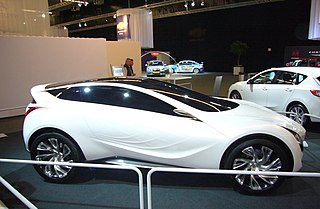
The Mazda Kazamai is a concept car made by the Japanese car manufacturer Mazda. It was first introduced at the 2008 Moscow International Motor Show in August.
Nagare(流, flow) is an automotive design language created by Franz von Holzhausen and Laurens van den Acker for Mazda. Incorporated into a number of concept cars, starting with the car of the same name, the Nagare design lineup was intended as a showcase of what Mazda's cars may have looked like in 2020.
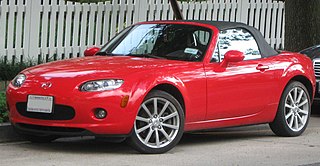
The Mazda MX-5 (NC) is the third generation of the Mazda MX-5 manufactured from 2005 to 2015. At its introduction in 2005, it won the Car of the Year Japan Award and made Car and Driver's 10Best list from 2006 to 2013.
The Mazda Ibuki was a concept car by Mazda revealed at the 2003 Tokyo Motor Show and the 2004 Chicago Auto Show. Although not its inspiration, the Ibuki previewed the third generation MX-5 ahead of its 2005 launch.
